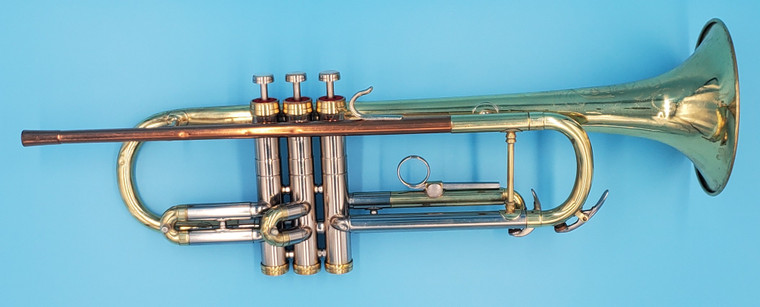
Pre-Owned Conn 6A Long Cornet in Lacquer!
CONNHere's a vintage long model Conn cornet, the wonderful 6A! Check out the three-metal color scheme with brass, Coprion, and nickel silver.
There are multiple dings, dents, and scratches along the leadpipe and bell, as well as the leadpipe connection to the third valve, as shown in the photos. Otherwise, this horn is in great shape!
From Conn Loyalist:
The 6A Victor Cornet is the long cornet version of the 6B Victor trumpet. This means that the mouthpiece receiver is built for a cornet mouthpiece and not a trumpet mouthpiece, and the internal bore is a bit different: the leadpipe is just an outer cover, hiding an inner leadpipe that tapers differently than it does on a trumpet. The "late" 6A has an adjustable 3rd slide finger ring, top spring valves and has a coprion leadpipe in addition to the nickel trim over brass. The late model model was styled after the 28A Connstellation, and was produced from 1958 to probably 1961, coinciding with the start of production of the 5A Victor short model. The 6A has a #1 bore (0.438").
The leadpipe used on the late model 6A Victor, as well as on the late models 6B, 10A, 10B and Connstellation models from 1958 on, are covered by patent number 3022697 which was filed on December 4, 1956 by Dr. Earle L Kent. In the patent Dr. Kent desribes the process and advantages of a single-piece, electroformed, mouthpipe. It is done by electroplating over a mandrel that has the exact shape of the inside of the mouthpiece receiver and leadpipe. Essentially the same process as for creating a coprion bell. Interestingly, while the patent application at first states that the mandrel is electroplated with a thin layer of protective metal such as nickel, gold, tin, platinum, rhodium or palladium, later on in the application it clearly says that "the nickel layer within the shell provides a smooth continuous layer over the interior of the combined mouthpipe and mouthpiece receiver which is resistant to corrosion, more easily cleaned, and has superior acoustical properties." Indeed, if you look down the inside of the mouthpiece receiver of such a leadpipe, it is gray and not copper colored. Another interesting thing: the diagram that goes with the patent application shows a long model cornet, and not a trumpet.
How to tell a 6A Victor long cornet and a 6B Victor trumpet apart? The differences are quite subtle, but you should be able to tell if you know what you are looking for. All models for which there is both a long cornet and a trumpet (6A/6B, 10A/10B, 28A/38B) have a letter "A" or "B" stamped on the mouthpiece receiver. An "A" indicates a cornet leadpipe, a "B" indicates a trumpet leadpipe. The second way is to look at where the leadpipe widens out to accomodate the main tuning slide. On a trumpet this happens directly after the leadpipe finger hook, on a long cornet about an inch further down the leadpipe from the fingerhook.
What Conn said in 1959:
Patterned after the Connstellation new acoustical design, this cornet adds more prestige to the famous Conn Victor name. This complete professional cornet offers any player exclusive features only Conn can build: seamless tone chamber, Cali-bore, clickless Crysteel valves with pin guide. Advanced styling and full bodied tone is making this cornet the choice of leaders everywhere. Finished with Lustre-Conn. Length 21 3/8", bell size 5 1/8".
This cornet is sold with no case or mouthpiece.














